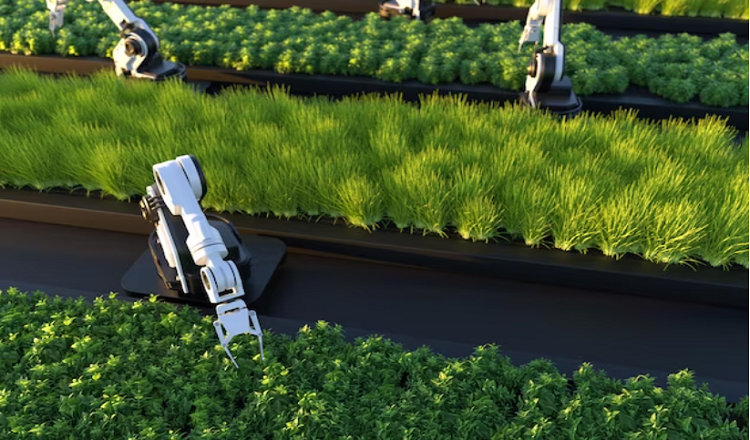Are you tired of toiling away in the fields, sunburned and exhausted, with nothing to show for it but a sore back and a meager harvest? Fear not, my friends, for the robots are here to save the day! That’s right, the latest technological innovations are making it possible to take the guesswork out of agriculture and increase productivity like never before.
Precision farming, the practice of using data analysis and technology to optimize crop yield and resource use, has become a game changer in modern agriculture. And at the forefront of this revolution are robots – autonomous machines that can do everything from tilling the soil to monitoring livestock. These robots are changing the way we farm, and for the better.
In this article, we’ll take a closer look at the use of robots in agriculture and precision farming. We’ll explore the different types of robots that are being used, the benefits of using robots in agriculture, and the challenges that come with adopting this technology. We’ll also highlight successful case studies of robots in action and discuss what the future of robots in agriculture might look like. So sit back, relax, and let’s dig into the exciting world of robots in agriculture
Types of robots used in precision farming
When it comes to precision farming, robots are a key component in helping to optimize crop yield and resource use. There are a wide variety of robots that are being used in agriculture, and each one has its own unique purpose and benefits.
One of the most commonly used robots in agriculture is the autonomous tractor or harvester. These machines can navigate fields and harvest crops with minimal human input, allowing for increased efficiency and reduced labor costs. Drones and aerial imaging systems are also commonly used in precision farming to monitor crop health, identify problem areas, and create detailed maps of fields.
Robotic weeders and sprayers are another type of robot that is becoming increasingly popular in agriculture. These machines can be programmed to identify and target specific plants or areas, reducing the need for widespread herbicide use. Soil sensors and analysis robots are also being used to provide detailed data on soil conditions, helping farmers make informed decisions about crop management. Finally, livestock monitoring and management robots can help farmers track animal health and manage herds more effectively.
Each of these types of robots plays an important role in precision farming, and as the technology continues to advance, we can expect to see even more innovative robots being used in agriculture.
Benefits of using robots in precision farming
The benefits of using robots in precision farming are numerous and significant. One of the biggest advantages is increased efficiency and productivity. By automating certain tasks and processes, robots can work around the clock and cover more ground than humans alone. This leads to reduced labor costs and physical strain for farmers, as well as a more streamlined and efficient workflow.
Robots in precision farming also enable more precise and targeted use of resources. With the help of sensors and other technology, robots can identify areas of the field that need more water or fertilizer, for example, and apply those resources only where they are needed. This leads to improved yield and crop quality, as well as a more sustainable and environmentally friendly approach to farming.
In addition to crop management, robots are also being used to better monitor and manage livestock, reducing stress on the animals and ensuring better overall health. Overall, the benefits of using robots in precision farming are clear, and as the technology continues to improve, we can expect even more innovative and effective solutions to emerge.
Challenges of adopting robots in precision farming
While the benefits of using robots in precision farming are clear, there are still several challenges that need to be addressed in order for widespread adoption to occur. One of the biggest challenges is cost and affordability, as many of the robots and technologies required for precision farming can be expensive.
Compatibility and interoperability issues are also a concern, as different systems and devices may not work together seamlessly. This can lead to additional costs and technical challenges for farmers.
Lack of technical expertise and training is another challenge, as farmers may not have the necessary skills or knowledge to effectively operate and maintain the robots and associated technology. Finally, data privacy and security concerns must also be addressed, as the use of robotics and other technologies in farming may lead to the collection and storage of sensitive information. Overall, while there are challenges to adopting robots in precision farming, the potential benefits make it an area worth exploring further
Successful case studies of robots in precision farming
There have been several successful case studies of robots being used in precision farming. One of the most notable examples is John Deere’s autonomous tractor technology, which allows tractors to operate independently, reducing the need for human labor and increasing efficiency.
Another successful application of robotics in agriculture is Blue River Technology’s robotic weeders, which use computer vision and machine learning to identify and remove weeds, reducing the need for herbicides.
Taranis’ aerial imaging system is another promising technology, allowing farmers to gather data and make decisions based on real-time information about crop health and soil conditions.
Lely’s robotic milking system has also been successful in improving efficiency and reducing labor costs on dairy farms. Lastly, Hands Free Hectare’s autonomous farming system is a groundbreaking project that has demonstrated the potential for fully autonomous farming, with no human intervention required.
Future of robots in precision farming
The future of robots in precision farming is exciting and full of potential. Advancements in artificial intelligence and machine learning are enabling robots to perform increasingly complex tasks and make more informed decisions based on real-time data. The greater interconnectivity of devices and systems, along with advanced data analysis, is also facilitating more efficient and effective farming practices.
As the technology continues to develop, we can expect to see the emergence of new robotic devices specifically designed for various agricultural tasks. These devices may include advanced sensors and analytics tools that can help farmers make more informed decisions about crop management and resource allocation.
However, the increased use of robots in precision farming may also have an impact on the job market and workforce. As robots become more capable, there may be a decrease in the need for certain types of manual labor, but there may also be an increase in the need for skilled workers who can operate and maintain these robotic devices. Overall, the future of robots in precision farming is one of innovation and exciting possibilities.
Conclusion
In summary, the use of robots in agriculture and precision farming has become increasingly prevalent and impactful in modern agriculture. Precision farming enables farmers to achieve higher crop yields and more efficient use of resources, leading to economic and environmental benefits. Robots such as autonomous tractors, aerial imaging systems, weeders, and sprayers, and livestock management robots have improved efficiency, accuracy, and productivity in farming operations. Despite the potential benefits, there are still challenges to overcome, including cost, interoperability, and data security.
However, the future of robots in precision farming is promising, with advancements in AI and machine learning, greater interconnectivity and data analysis, and the emergence of new robotic devices. The use of robots in precision farming is expected to transform the industry and improve farming practices, but it is crucial to address the challenges and ensure their safe and effective use.




